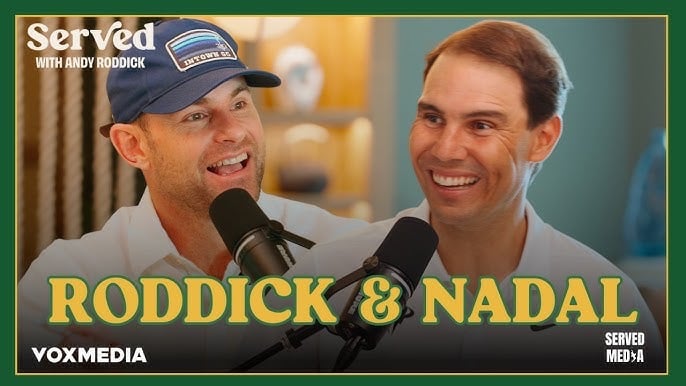Roddick’s Interview With Nadal
One Of The Best Rafa Interviews Ever
4/16/20254 min read


Indian Wells was an amazing tournament this year, but I’m sure everyone felt a big absence in the Coachella Valley without Rafael Nadal. Although he wasn’t at the courts playing, he still appeared on The Serve Tennis Podcast. I was looking forward to this day for a while because Andy Roddick had announced the interview with Rafael Nadal, and it was finally released a month ago. It is by far the best interview with Rafael Nadal that I've ever heard. A big shout-out to Andy Roddick, who conducted a great interview.
I want you to actually go watch the interview and help Andy get more views and grow his channel because The Serve Podcast is a blessing. I hope that Andy can get more legends of the game as interviewees—maybe Roger Federer, Pete Sampras, Andre Agassi, Steffi Graf—the list goes on and on.
Emotional Roller Coaster
In the case of Rafa's interview with Andy Roddick, I want to point out a few things that confirmed some of the things I've been saying about Rafa. First and foremost, what I've been saying for a long time is that when Rafa, Federer, or Djokovic win a huge title—a Grand Slam—they are very happy. Sometimes they cry or throw themselves on the court; they're very emotional. But as the press conference goes on, the emotions start to fade away, and their game face comes back on. I was so happy to hear Rafa confirm this in the interview on The Serve Podcast.
Rafa mentioned that in 2005, after winning his first French Open, he let his emotions get too high. As a tennis player, you should not let your highs get too high or your lows get too low. Rafa admitted that he spent too much time thinking about being a French Open champion and didn’t focus on the grass season like he should have.
As a result, he lost in the first round of Halle to Alexander Waske and then lost to Gilles Müller at Wimbledon. However, Rafa learned from this mistake. The following year, right after winning the French Open, his mind immediately shifted to focusing on grass season. He even practiced on grass the very next day.
Best Surfaces
Speaking of grass courts, it was great to hear Rafa say that grass was his second favorite surface. I've always believed that Rafa is one of the greatest grass-court players in history. Back in 2022, Nadal won two Grand Slams and was at the top of the tennis world, so you could make that argument then that Rafa was the GOAT.
Obviously, Rafa Nadal is the greatest clay-court player in tennis history. As Andy Roddick said in the interview, Pete Sampras broke the record for most Grand Slams with 14—but Nadal has 14 Grand Slams at just one tournament (the French Open). Nadal will always be the King of Clay; no one will beat that record as long as I'm alive.
When it comes to hard courts, Novak Djokovic is undoubtedly the greatest hard-court player in history—closely followed by Roger Federer. On grass courts, it's a toss-up between Djokovic and Federer for the top spot. Djokovic has beaten Federer in three Wimbledon finals—a fact that's important when discussing who is truly the greatest grass-court player of all time.
Skidding On Grass
I would rank Rafa as the seventh-best grass-court player in history but with an added caveat: Wimbledon’s grass has changed over time. It has become slower due to changes in how it’s grown and how balls are prepared. My belief has always been that if Rafa could manage to get through Wimbledon’s first week—when grass is still fast—he would thrive in week two when worn patches behind the baseline make it play more like clay.
Rafa’s ability on grass was confirmed during his interview with Andy when he said grass was his second favorite surface. However, what I didn’t know before this interview was how much Rafa struggled with knee issues on grass for many years—leading to shocking losses against players like Dustin Brown, Steve Darcis, and Nick Kyrgios.
Rafa also mentioned something fascinating: his serve was more effective on grass than hard courts because he got more free points there—likely due to his excellent slice serve responding better on grass.
Building Strategies
Another interesting part of Andy's interview was when he asked Rafa how he strategized against Federer and Djokovic. Against Federer, Nadal said he obviously attacked Roger’s backhand—a strategy we all know well—but acknowledged that in 2017 Federer began hitting his backhand differently.
What stood out most was Nadal’s description of facing Djokovic: there wasn’t any specific strategy against him because Novak doesn’t have any weaknesses. Nadal called Djokovic’s ball control the greatest in tennis history—a combination of technique, timing, footwork, and mental strength.
This reminded me of a story from when Novak was 13 years old at Niki Pilić’s Tennis Academy in Munich. During a hitting session with Goran Ivanišević, Novak didn’t miss a single ball into the net for half an hour—an early sign of his extraordinary precision.
The rivalry between Nadal and Djokovic is fascinating because it’s less about contrasting styles (as with Nadal vs Federer) and more about two players battling at their absolute peak without clear weaknesses.
Final Thoughts
Finally, something else from this interview struck me: Nadal's ability to slide into shots on both sides (forehand and backhand) gave him an incredible advantage on clay courts—something most players struggle with even today.
Andy Roddick's podcast is doing amazing things for tennis fans by giving us insights into legends like Rafael Nadal. Now that Nadal has retired from professional tennis, it’s wonderful to see him open up about his career and share knowledge that can help grow our understanding of this beautiful sport. Hopefully he considers taking on the role of a coach in the near future.
